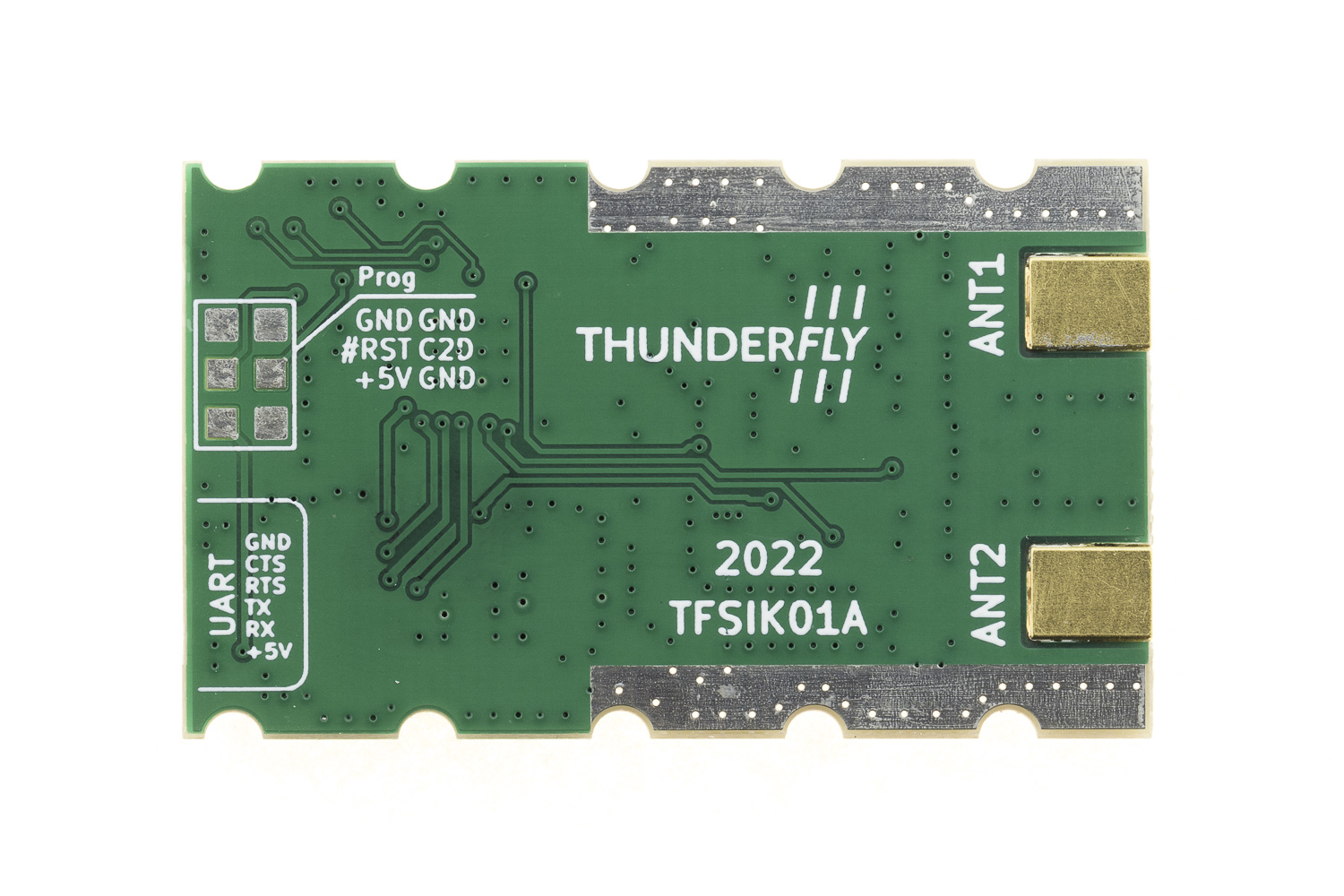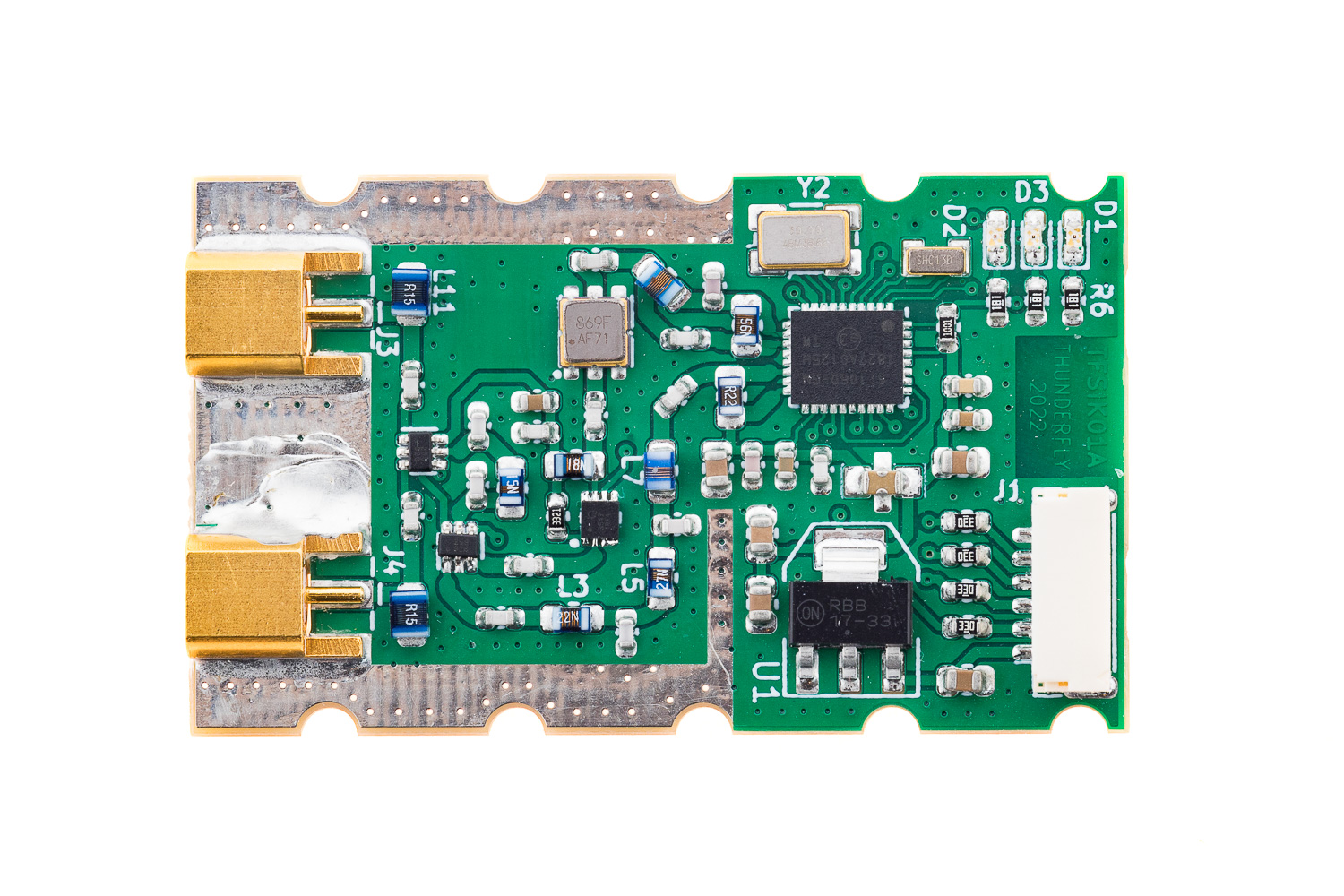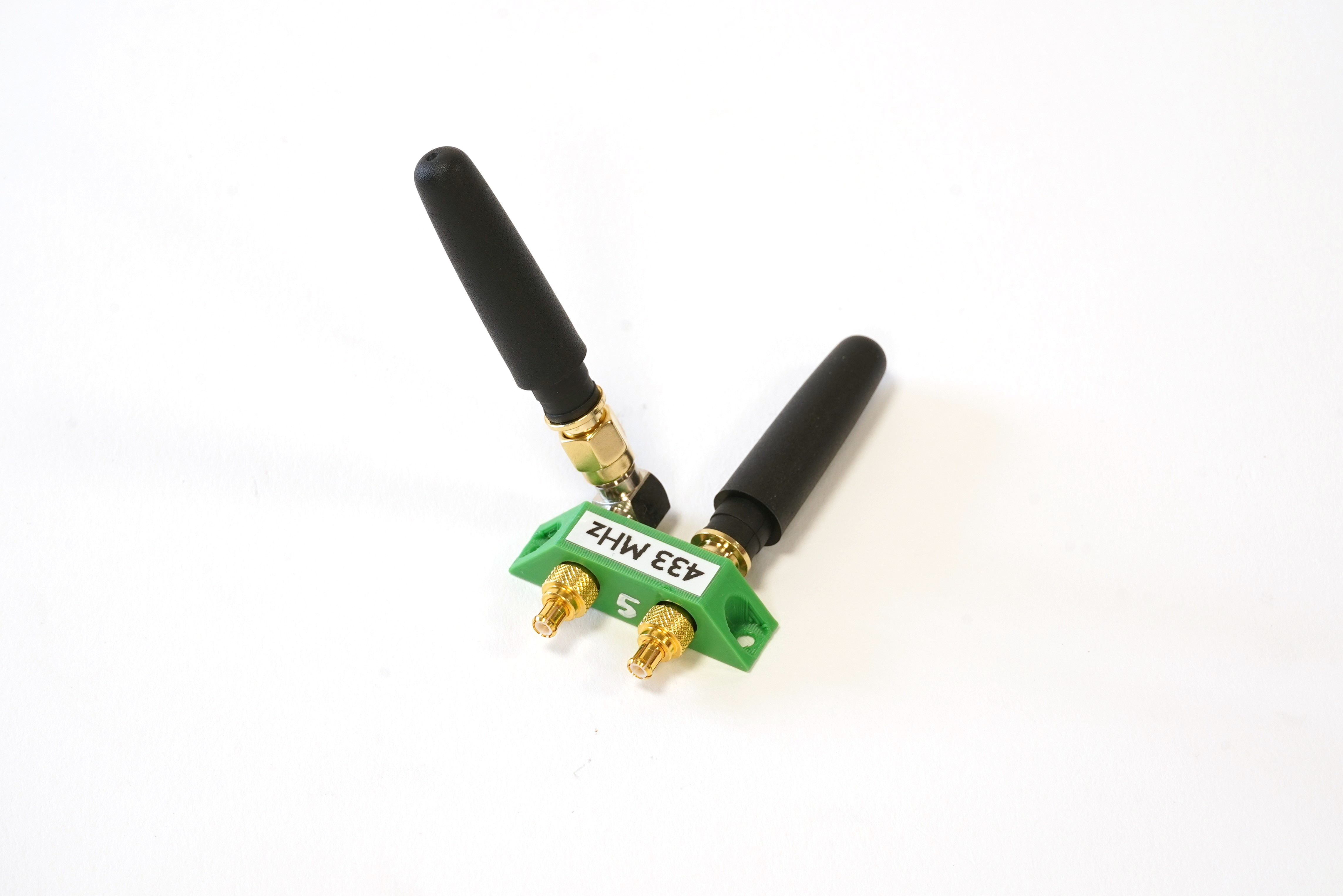The TFSIK01A is a high-end open-source hardware design of a UAV modem with SiK firmware. It uses the latest Si1000 series chip Si1060 which is equipped with Si4463 EZRadioPRO Transceiver. The RF front is designed to have high immunity to the jamming on out-band frequencies, this gives TFSIK special features such as being operable in the proximity of out-of-used band signal jammers. RF noise immunity is a hardware-based feature, therefore it is extremely reliable, but the proper antenna and frequency band must be used for the best results—contact ThunderFly s.r.o. to get support and consultation.
TFSIK modem is enclosed in a 3D printed box suitable for user modification. Inside that box are electronics with electromagnetic shielding.
Here is a photo of TFSIK electronics without an electromagnetic shielding cover.
External antennas are connected to the TFSIK modem by a pair of two MCX connectors. For ease of use, we prepared a kit with simple whip antennas. This kit could be manufactured for multiple frequency bands. Here is 433 MHz as an example. The antenna kit strictly pairs only with the TFSIK modem tuned on the same frequency band.
As you can see the antenna kit contains two asymmetrically mounted antenna. The antenna is tightened in position by SMA connectors. The optimal position depends on your exact setup, but generally, the antennae should be orthogonal to each other due to their "donut" radiation patterns. The whole setup of TFSIK01 with the antenna kit should be mounted on by pair of screws in the holes of the antenna kit.
- Small size and Lightweight (under 20 grams without antenna)
- Automatic antenna switching
- Transparent serial link
- Air data rates up to 250kbps
- MAVLink protocol framing and status reporting
- Frequency-hopping spread spectrum (FHSS)
- Adaptive time division multiplexing (TDM)
- Support for listening before talk (LBT) and Adaptive Frequency Agility (AFA)
- Demonstrated range of several kilometers with a small whip antenna
- Open source firmware
- AT commands for local radio configuration
- RT commands for remote radio configuration
- Supported protocol: MAVLink 2
- Configurable duty cycle
- Built-in error correcting code (can correct up to 25% of data bit errors)
- Supported bands: 433MHz, 868 MHz. (Other frequencies are available upon request)
- Interface: Pixhawk compatible JST-GH UART link
- Transceiver chip: Si4463
- User-selectable output power up to +20 dBm (100mW) (The maximum legally allowed power output for most ISM bands)
- RX Sensitivity -124 dBm @ 1000 bps FSK
- MIMO 2x2 RX/TX: Two antenna diversity
- Two separated MCX connectors RX and TX on the each connector
- RF switch: SPDT High Power UltraCMOS 10 MHz - 3 GHz
- RF input low noise amplifier
- 50MHz to 4000MHz, GaAs pHEMT SPF5189
- Noise Figure 0.60dB
- High noise immunity OIP3 39.5dBm
- Gain 18.7dB
- Filter: SAW AFS selected for used frequency band
The above parameters are guaranteed only in case of the use of a proper RF antenna matched for a given frequency band. When using an improper antenna with a radio modem (VSWR above 1.5:1), there may arise several issues that could affect the performance, efficiency, and reliability of the system. Here is a simplified list:
- Reduced Range - The most immediate problem would be a reduced operating range. The antenna is critical for transmitting and receiving signals effectively. An improper antenna may result in weaker signals, thereby limiting the distance over which the modem can communicate.
- Signal Degradation - Poorly matched antennas could degrade the quality of the transmitted and received signals. This can lead to higher bit error rates, packet loss, and data corruption, impacting the reliability of the system.
- Increased Interference - The wrong type or tuning of the antenna might pick up or transmit on unintended frequencies, causing interference with other systems or devices. This could be particularly problematic in crowded or jammed frequency bands.
- Power Imbalance - The impedance mismatch between the antenna and the modem can result in a portion of the signal being reflected into the modem. This can potentially damage the modem’s internal components over time due to the stress of components.
- Non-Compliance - Using an improper antenna may lead to non-compliance with regulatory standards, which could result in legal issues or fines. Regulations often specify the types of antennas that can be used with particular types of modems or in specific frequency bands.
- Energy Inefficiency - A mismatched antenna can be energy-inefficient, drawing more power than necessary to achieve a given range or data rate. This could be particularly problematic in battery-powered applications.
- Increased Latency - Poor signal strength and quality could also result in increased latency due to packet retransmissions, affecting real-time applications like telemetry transmission.
- Difficulty in Troubleshooting - An improper antenna can introduce a myriad of issues that can be hard to diagnose. This could result in increased downtime and maintenance costs, as engineers would need to spend additional time identifying and resolving the issues.
The TFSIK modem is intended to be used at UAV as an "in the air" part of the communication link. For the ground control station, the TFMODEM is supposed to be used.
The reasons for the difference in the air and ground control station units are design tradeoffs.
For the example, the ground control unit needs a very reliable, therefore there is a large interface USB connector, to the ground control station computer.
The same connector is impractical to be used in the UAV part. Similar restrictions apply to the RF filters, antenna connectors, etc. To resolve that, we decided to use different implementations of the ground station.
SiK firmware is commonly used in radio modems, particularly in the fields of unmanned aerial vehicles (UAVs) and robotics. When integrated into a Robot Operating System (ROS) or ROS2 environment, SiK technology offers several advantages. It provides reliable and long-range communication, which is crucial for both indoor and outdoor robotic applications. The low latency of TFSIK01 modems ensures real-time responsiveness, a critical factor in robotics. These modems are highly configurable, offering users the flexibility to tailor the system according to specific needs. Additionally, their compatibility with various communication protocols makes them easy to integrate into existing ROS and ROS2 systems.
The easiest solution is the use of TFUSBSERIAL01 gadget to create a virtual UART/Serial link from a USB-A or USB-C connector.
The device can be purchased from ThunderFly s.r.o.. Contact us by email at info@thunderfly.cz for a commercial quotation. We are designers of this modem and therefore have full control of the modem construction and design. This gives us the ability to react even on non-standard requests for modification or functions.


